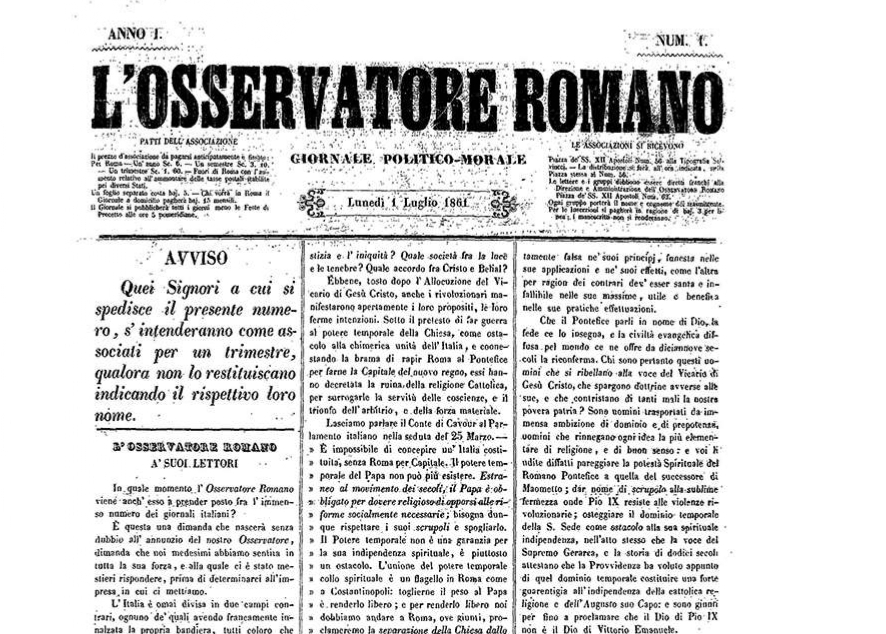“I read it every day and, when it doesn’t come out on Sunday, I’m lacking something,” said Pope Francis, referring to the Vatican’s newspaper L’Osservatore Romano, which on July 1 observes its 160th anniversary. In this text, to be published this Thursday, the Holy Father adds his passion for “the party newspaper,” which “is old.” He described it so also at yesterday’s Angelus,” on the Solemnity of Saints Peter and Paul, announcing in fact the paper’s 160th anniversary. “Also in Argentina, I read the whole the weekly edition in Spanish, because I know it’s a link with the Holy See, with the Magisterium and with the life of the Church, with the history of the Church.”
The Pontiff had already said this to journalists on June 2, 2019, on the return flight from Rumania. “I read the party newspaper and you too should do so, because it’s a newspaper that offers interpretive keys and what I think is there, in those pages.”
He summarized in two words the mission that, for 160 years, this “most singular daily” (as it was described by Cardinal Montini on its centenary in 1961) takes forward: to document the thought, words, works of the Pope and of the Holy See and to offer readers interpretive keys of the historical and spiritual reality of Catholicism and of the time we have been given to live, a read time, “observed” from Rome, with the eyes of the Church.
Five Special Inserts
To celebrate the 160th anniversary, from July 1-5 L’Osservatore Romano will issue five “special” inserts, which inaugurate a series of initiatives programmed throughout this anniversary year, with other special editions and events. The spirit that moves the Editorial Board is not that of the nostalgic celebration of a glorious past. It is, rather, a purposeful impetus, open to the challenge of the future on which it hopes to open a discussion, ask a question: if it’s true that we are living a “change of era,” how is journalism changing and how do we want it to be transformed? Can the Encyclical Fratelli Tutti be an indication of the way of a “journalism of brotherhood” as an answer to the crisis that the irruption of the pandemic has re-proposed in a dramatic and unavoidable way?
The Opinion of Authoritative Directors
The question was posed to Directors of different Italian and international newspapers and the answers — notable for quantity and quality –, were brought together in the special inserts that will be published from tomorrow: the Directors of El Pais and Le Monde, of Avvenire, Corriere della Sera and La Repubblica, of the Fohla de S. Paulo and of Limes, of La Semaine Africaine and of Scarp de’Tennis, which did not refrain from taking part and reflected and used their imagination in a concrete, constructive way.
While celebrating, L’Osservatore Romano continues at the same time its development program, marked by the integration between the paper and digital edition in strong and promising growth, which opens to new future projects. It is an effort of modernization that over the last two years has witnessed an acceleration with the launching, last October 4 — on the occasion of the issue of Fratelli Tutti –, of the reconceived newspaper, renewed in the contents, in the format, and in the graphics.
Female Signatures
In fact on July 1, for the first time the rubric on the first page “The Good News,” weekly meditation on the Sunday Gospel, has been entrusted to the authoritative signature of five women experts on the Bible and spirituality, some of whom are already collaborators of Donne Chiesa Mondo [Women Church World]. Last May the women’s monthly passed the stage of one hundred numbers and continues its adventure forcefully under the guidance of the Editorial Committee coordinated by Rita Pinci. Sister Maria Ignazia Angelini, Abbess of the Benedictine Abbey of Viboldone begins the series of meditations written by women. Lucia Vantini, Rosalba Manes, Rosella Barzotti and Sister Fulvia Sieni will follow her. Openness to the future, therefore, together with an awareness of a strong past of 160 years, which has witnessed L’Osservatore Romano live as protagonist of the small and big events of men’s history.
The Story of Its Birth
L’Osservatore Romano is, in fact, the oldest daily in activity among those that are printed in the Eternal City. The first number came out in fact on July 1, 1861, immediately after the proclamation of the Kingdom of Italy, and it took up the name of a previous private sheet (September 1849-1852), financed by a French legitimist Catholic group. Among the most famous and quoted newspapers in the world, it has a reduced foliation and a limited edition in relation to the most widespread dailies, but it’s unique characteristics make it a source of primary importance, especially for the history of the Church and of the papacy in the modern and contemporary age.
Translation by Virginia M. Forrester










